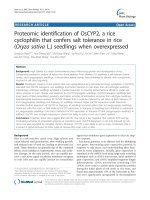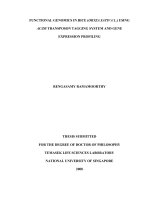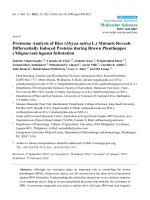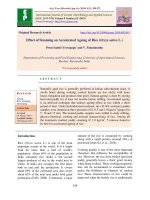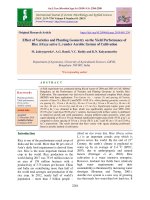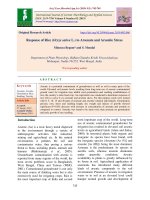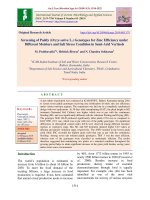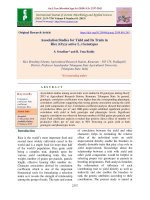Identification of candidate gene based markers (SNPs) in the ZIP family transporter sequences of rice (Oryza sativa L.)
Bạn đang xem bản rút gọn của tài liệu. Xem và tải ngay bản đầy đủ của tài liệu tại đây (423.25 KB, 13 trang )
Int.J.Curr.Microbiol.App.Sci (2019) 8(1): 2830-2842
International Journal of Current Microbiology and Applied Sciences
ISSN: 2319-7706 Volume 8 Number 01 (2019)
Journal homepage:
Original Research Article
/>
Identification of Candidate Gene based Markers (SNPs) in the ZIP Family
Transporter Sequences of Rice (Oryza sativa L.)
Saurabh Pandey*, D. Dayal Doss and H.E. Shashidhar
Department of Plant Biotechnology, University of Agricultural Sciences, Bangalore-65, India
*Corresponding author
ABSTRACT
Keywords
Candidate gene,
SNPs, ZIP Family,
Oryza sativa,
OsZIP
Article Info
Accepted:
17 December 2018
Available Online:
10 January 2019
Iron and Zinc are the key ingredient in human nutrition, soil and crop management. Rice is
the major dietary source for the population in India but it is deficient in iron and zinc. An
effort was made to quantify the iron and zinc content in brown, white and cooked white
rice and to study the effect of nucleotide variations in genes associated with zinc. 14
genotypes were selected and grown in field at UAS, GKVK in RCBD, during Kharif-2014.
Quality parameter zinc in brown rice showed negative effect on yield. Highly positively
significant correlation was observed for grain yield with number of productive tillers.
Literature survey revealed genes belonging to transporter family OsZIP are involved in
transporting zinc. Primers were designed specific to these genes. The primer profile at gel
level was monomorphic for all the primers. Sequencing the amplicons of primersOsZIP2-1
and OsZIP7-2 revealed that variations were present in all these amplicons but nucleotide
changes at ninth position of OsZIP2-1 were significantly associated with brown rice zinc
content and nucleotide changes at 25, 40 and 551 positions of OsZIP7-2 were significantly
associated with grain iron content. Although OsZIP2-1 and OsZIP7-2 were monomorphic
at gel level nucleotide variations were significantly associated with grain iron and zinc
content. The markers identified in this study can be used for improving the grain iron and
zinc in rice.
Introduction
Rice (Oryza sativa L.) is a “Global Grain”
cultivated widely across the world feeding
millions of mankind. It has been reported that
rice significantly lack some of the
micronutrients such as Fe, Zn, Ca, Mg, Cu, I
and Se etc., which are important for human
beings for their proper growth and
development (Banerjee and Chandel, 2011)
especially after polishing. Taking weight
percentage into account, in rice 43 % of the
total Zn, 65 % of the total Fe, and 85 %, 92 %
of the total K, Ca and Mn were removed by
the milling process if the hull and bran tissues
(embryo + aleurone layer) were thoroughly
removed from the endosperm fraction during
polishing (Lu et al., 2013).Thus, a rice-based
diet is the primary cause of micronutrient
malnutrition throughout much of the
developing world. Iron, zinc, and vitamin A
deficiencies are common in rice consuming
regions. These deficiencies account for
decreased work productivity, reduced mental
2830
Int.J.Curr.Microbiol.App.Sci (2019) 8(1): 2830-2842
capacity, stunting, blindness, increased child
mortality, and elevated morbidity and
mortality in general (Baishya et al., 2015)
Biofortification represents one promising
strategy to enhance the availability of vitamins
and minerals for people whose diets are
dominated by micronutrient-poor staple food
crops. It involves the identification of varieties
of a crop that naturally contain high densities
of certain micronutrients. Plant breeders use
these varieties to develop new, productive and
„biofortified‟ crop lines for farmers to grow,
market and consume (Global Panel, 2015).
Biofortified crops are being developed or
adapted by national agricultural programmes
in many low and middle income countries
(Harvest Plus 2014).
Enormous increase in the availability of the
DNA sequences in the databases has increased
the potentiality of identifying SSRs and SNPs
(Single Nucleotide Polymorphism) by
database mining. SNPs are gaining importance
in the field of MAS, fueled by ever-increasing
sequence data which is publically available.
These databases revealed the abundance of
SNPs (Sharma and Chauhan 2008).The
availability of huge set of databases and also
advanced computational genomic tools has
provided an opportunity to analyze any
sequence for SSR, SNP loci as well as
putative CGs responsible for trait of interest.
Further, the ever-emerging bioinformatics
tools will help in profiling the expression
pattern of these CGs and thus identification of
most suitable and selective targets for further
manipulations in order to improve that trait
(Chandel et al., 2011). Chandel et al., (2011)
characterized five QTLs, two for QTLs for Fe
and three for Zn content in rice. They have
scanned the selected QTLs, results revealed
that these QTLs comprises of BAC/PAC
clones. This result leads to the identification of
eight CGs which are predicted to be involved
in activities of uptake, transport and
accumulation of Fe and Zn in rice. It is also
reported that over expression of single genes,
which are earlier reported as CGs for Fe and
Zn concentration, has increased the Fe
(Johnson et al., 2011) and Zn (Lee et al.,
2009)
concentration
in
rice
grains,
respectively.
Identifying genomic sequences associated
with Zinc and designing molecular markers
for possible MAS seems an attractive
proposition. Candidate gene (CG) approach
(Byrne and Mcmullen, 1996) is an attractive
strategy. This approach is based on exploiting
the information on the role and functions of a
particular coding sequence and hypothesizing
a plausible cause-effect relationship between
the QTL and a feasible candidate gene
mapping nearby (Tuberosa and Salvi,
2007).Sequencing these candidate genes and
associating the differences in the nucleotide
level with the phenotypic variations would
give some novel information.
Materials and Methods
Plant materials
The present experiment was conducted
ataerobic rice laboratory, Department of Plant
Biotechnology, University of Agricultural
Sciences, GKVK campus, Bangalore, India
during Kharif-2014in order to evaluate the
performance of fourteen genotypes of rice for
various yield and its component traits.
The genotypes were sown in rows spaced at
30 cm apart with intra-row spacing of
15cmwiththree replications each. Fourteen
genotypes were selected for the study based
on earlier studies of Bekele (2012) using more
than 1200 rice accessions. These studies were
based on AAS and XRF based analysis of Zn
and Fe estimation. The list of the selected
genotypes is given in Table 1.
2831
Int.J.Curr.Microbiol.App.Sci (2019) 8(1): 2830-2842
pattern was recorded directly and later with
Alpha Innotech gel documentation instrument.
Isolation of genomic DNA
DNA extraction from fourteen genotypes was
done using CTAB method from young leaves
tissues as per the protocol described by Doyle
and Doyle (1990) as below.DNA quality was
checked on 0.8% agarose gel. The genomic
DNA was quantified spectrophotometrically
both at 260 nm and 280 nm wavelength.
Normalization of the DNA concentration was
done to bring all the DNA concentrations to a
relatively equal level (25 ng/µl) by appropriate
dilutions for PCR reaction.
Exploring the genes associated with zinc
and iron transportation in rice
All the genes reported to be associated with
Zn and Fe transport in rice have been
explored. All the potential genes are enlisted
in Table 3.Genomic DNA sequence of all the
target genes was downloaded. Primers specific
to genes associated with Zn and Fe content
were designed by using the "pick primer" tool
of NCBI in collaboration with Primer3 (Ye et
al., 2012).
PCR for candidate markers was performed in
a total volume of 20 l containing 1X PCR
buffer (contains 10 mM Tris-HCl, pH 8.0 at
25 0C, 50 mM KCl, 1.5 mM MgCl2), 0.25 µM
of each forward and reverse primers (Sigma
Aldrich, USA), 50 ng rice genomic DNA, 0.5
mM dNTPs mix and 1.2 units of Taq
polymerase (Bangalore Genei,
India).
Condition for PCR amplification was given in
the table 2.
For checking the genotypic variation among
all the genotypes PCR product was run on
agarose gel (3.0 %). Care was taken to prevent
mixing of samples between the wells. A
voltage of 5 V/cm was given for a time period
of three hours for separation of PCR
fragments. The gel was viewed under UV
trans-illuminator and the DNA banding
Screening of
polymorphism
candidate
markers
for
A total of 20 candidate gene markers designed
based on the strategy described earlier, were
screened to discern their amplification
profiles. The bands generated by gene specific
primers were scored as „1‟ for bands of higher
size bands, „3‟ for lower size and „2‟ for those
showing both the bands.
Single-marker analysis
Single-marker analysis was done with the help
of student‟s t-test distribution given by Gosset
in 1908.
X1 - X2
------------------SP2 (1/n1+1/n2)
t=
Wherein,
X1:
mean of trait of interest under
investigation in individuals of marker class I
X2:
mean of trait of interest under
investigation in individuals of marker class II
SP2: Pooled variance
n1:
number of genotypes in marker class I
n2:
number of genotypes in marker class II
S12 (n1-1) + S22 (n2-1)
SP = ------------------------------n1+ n2- 2
2
Wherein,
S12:
variance of trait of interest for marker
class I
S22: variance of trait of interest for marker
class II
Calculated t-value was compared with table tvalue at (n1+ n2- 2) degrees of freedom at 5 %
and 1 % of probability.
2832
Int.J.Curr.Microbiol.App.Sci (2019) 8(1): 2830-2842
Sequencing the amplified products and
establishing associations with the phenotype
Sequencing of the amplified product(s) was
outsourced to "Indus Biotech Pvt. Limited
Bangalore". Sequences obtained were then
aligned
using
'clustalw'
tool
/>kin et al., 2007). All sequences of fourteen
genotypes were aligned in this tool to discern
the variations existing in the sequences.
Jalview tool (Waterhouse et al., 2009) of the
clustalw website was used for the
identification of the variations present in these
sequences. Once the sequences were aligned,
change at each base was recorded, statistical
analysis was done to establish association(s) if
any. Each possible change at any position of
the sequence was scored. For sequences
having same nucleotide as the consensus
sequences was given code "1", any change
was scored as 2, 3 or 4 depending upon the
nucleotide substituted. In case of deletion at
that locus, it was scored as 0. These scores
were then used for the analysis using SPSS for
associating these variations in the nucleotide
level with the phenotypic variation for Zn and
Fe content in brown rice and white rice.
Results and Discussion
The list of all the zinc transporters obtained by
literature survey is shown in Table 3.Primers
specific to the nucleotide sequences of zinc
and iron transporters is given in Table 14. The
expected product size of the primers designed
ranged from 484bp to 1090bp, and annealing
temperature from 57.60 C to 720 C. All the
primers screened for all the genotypes with
designed molecular markers. All the
20primers are monomorphic. Monomorphic
agarose gel picture is presented in Plate 3, 4
and 5.
Amplified products of two primers (out of 20
gene specific primers) from fourteen
genotypes were send for sequencing. The
length of each amplicon varied within each
primers. OsZIP 7-2 having 602bp instead of
expected size of 484 bp this may be due to
insertion of segment. OsZIP 2-1 having 745bp
product size instead of expected size of 752
bp.
Identification of the variations in the
sequences
The fourteen sequences of each genotype were
subjected to alignment using Clustalw
( />The pattern of similarities or dissimilarities, in
amplicons and the positions where these
occur, was recorded.
All the amplicons were found to have
variations at nucleotide level which were less
in OsZIP 2-1 (only two). Most of the sequence
variation was found in OsZIP7-2 amplicon at
nucleotide level.
In case of OsZIP 2-1 there has been changes at
2 positions, at 9 position transversion from A
to T were found for three genotypes, where
transversion from A to C were found for four
genotypes; at 12 position transition from A to
G for two genotypes, transversion from A to C
for two genotypes and transversion from A to
T for four genotypes were found.
In case of OsZIP 7-2, changes were noticed at
26 positions which were mostly deletions. At
positions 464 and 542 deletions were found
for T; deletions at 540 and 543 were found for
G; 544th position for A; 541th position for C.
Deletions as well as change in nucleotides to T
could be seen at 34th position from A and G;
64th position from G; 516th position from G;
545th position from C; 553th position from A
and C. Changes were also found at 25th
positions for C to T,G and A; at 26 for G to T
and A; at 31th position for G to A and T. More
changes were observed at 33rd position for G
2833
Int.J.Curr.Microbiol.App.Sci (2019) 8(1): 2830-2842
to A and T; at 41th position for C to A and G;
at 48th position for C to G; at 488th position
from T to C and A; at 534 from G to C with
deletions for G; at 548th from C to T with
deletions for C: at 549th position from C to G
with deletions for C; at 550th position from A
to G and C With deletions for A; at 551th
position from C to G with deletions for C; at
552th position from G to C with deletions for
G were observed. Nucleotide variation is
presented in table 5 and 6.
Associating the nucleotide variation with
phenotypic variation
Both primers which manifested changes in
nucleotides for the fourteen genotypes were
selected. The analysis of scores in SPSS
(Statistical Product and Service Solutions)
package revealed the association of these
sequence changes with the phenotypes.
Results are summarized in Table 6 and table 7.
OsZIP 2-1 showed association with only
brown rice Zinc among the selected
genotypes. It showed association with Zinc in
brown rice at two nucleotide positions 09 and
12 with a phenotypic variance of 83.0 % and
67.5 % in all the respective nucleotide
positions.
OsZIP 7-2 showed association with Zinc
content in brown rice at nucleotide position 25
with a phenotypic variance of 66.2 %, at
nucleotide position 26 with a phenotypic
variance of 62.7 % and at nucleotide position
31 with a phenotypic variance of 69.7 %.
OsZIP 7-2 showed association with Iron
content in brown rice at different nucleotide
positions with varying phenotyping variation
as shown in table 5. Zinc and Iron form the
important part of micronutrients used for
essential physiological processes of human
beings. Zinc and Iron accumulation is under
the influence of many genes (Avendano, 2000;
Lu et al., 2008; Zhang et al., 2011). To
improve the micronutrient bioavailability
these genes which are involved in
transportation need to be understood properly.
Our focus lies on understanding the molecular
mechanism behind regulation of Zn and Fe
haemostasis network in all elite accessions as
its discerning is the major bottle neck for
biofortification (Ahmad et al., 2014).
Brown rice, as found in our research(Pandey
et al., 2018a, Pandey et al., 2018b, Pandey et
al., 2018c) also contained high Fe and Zn, but
only very poor and highly health conscious
people prefer to eat it. Majority of people
prefer white rice though it is significantly less
nutritious as almost 70 % of micronutrients
are lost during polishing (Sellapan et al.,
2009).
Gene-specific markers usually tend to become
monomorphic.
Monomorphism
is
an
indication of size similarity and not of the
sequence. Sequencing of the products obtained
by amplifying the DNA would reveal the
minute nucleotide level change which may
actually be associated with variation in zinc
content. Thus sequencing the amplicons would
provide more raw data.
There are many genes belonging to family of
OsZIP, OsYSL, OsNramp, OsMTP, OsNAS,
and APRT. All the genes in these families
need to be explored in depth to obtain a clear
idea about how these transporters are working
and how the available knowledge can be
employed to enhance the zinc and iron content
in rice grains. Especially, genes like OsZIP
need to study to a greater extent which
t����������������������������������������������������������������������������������������������������������������������������������������������������������������������������������������������������������������������������������������������������������������������������������������������������������������������������������������������������������������������������������������������������������������������������������������������������������������������������������������������������������������������������������������������������������������������������������������������������������������������������������������������������������������������������������������������������������������������������������������������������������������������������������������������������������������������������������������������������������������������������������������������������������������������������������������������������������������������������������������������������������������������������������������������������������������������������������������������������������������������������������������������������������������������������������������������������������������������������������������������������������������������������������������������������������������������������������������������������������������������������������������������������������������������������������������������������������������������������������������������������������������������������������������������������������������������������������������������������������������������������������������������������������������������������������������������������������������������������������������������������������������������������������������������������������������������������������������������������������������������������������������������������������������������������������������������������������������������������������������������������������������������������������������������������������������������������������������������������������������������������������������������������������������������������������������������������������������������������������������������������������������������������������������������������������������������������������������������������������������������������������������������������������������������������������������������������������������������������������������������������������������������������������������������������������������������������������������������������������������������������������������������������������������������������������������������������������������������������������������������������������������������������������������������������������������������������������������������������������������������������������������������������������������������������������������������������������������������������������������������������������������������������������������������������������������������������������������������������������������������������������������������������������������������������������������������������������������������������������������������������������������������������������������������������������������������������������������������������������������������������������������������������������������������������������������������������������������������������������������������������������������������������������������������������������������������������������������������������������������������������������������������������������������������������������������������������������������������������������������������������������������������������������������������������������������������������������������������������������������������������������������������������������������������������������������������������������������������������������������������������������������������������������������������������������������������������������������������������������������������������������������������������������������������������������������������������������������������������������������������������������������Brown Rice
Brown Rice
Brown Rice
Brown Rice
Brown Rice
Brown Rice
Brown Rice
Brown Rice
Brown Rice
Brown Rice
Brown Rice
Brown Rice
Brown Rice
Brown Rice
Brown Rice
Brown Rice
Brown Rice
Brown Rice
Brown Rice
Brown Rice
Brown Rice
Brown Rice
P value
0.01
0.04
0.02
0.00
0.02
0.00
0.00
0.01
0.05
0.00
0.03
0.00
0.00
0.00
0.00
0.01
0.00
0.01
0.01
0.04
0.00
0.01
0.03
2837
R2 value
70.6
43.8
60.8
62.0
49.6
58.0
49.4
53.8
27.8
57.8
47.1
53.8
53.8
53.8
53.8
38.4
58.6
55.3
53.8
54.3
62.0
55.8
56.2
Int.J.Curr.Microbiol.App.Sci (2019) 8(1): 2830-2842
Table.7 Nucleotide variations observed in OsZIP 7- 2
Sl.
No.
1
2
3
4
5
6
7
8
9
10
11
12
13
14
GENO
TYPES
AM 27
AM 65
AM 72
AM 158
Black rice
BI 33
AM 143
AM 1
RadhuniP
agal
BR 2655
Karthika
Subhdra
Morobere
kkan
TKM 9
25
C
C
C
T
T
31
G
A
G
G
G
G
G
G
G
33
G
A
T
G
G
G
G
G
T
34
T
T
T
C
C
G
26
T
A
T
G
G
G
G
G
G
G
A
G
A
A
G
A
G
G
G
A
T
G
T
G
A
C
G
G
A
A
40
T
T
T
T
T
T
T
T
T
41
C
A
C
C
C
C
C
C
C
43
T
G
T
T
T
T
T
T
T
48
C
C
C
C
C
C
C
C
C
64
A
T
C
T
G
T
G
C
C
C
T
T
G
T
G
C
C
C
T
C
T
C
T
464
T
T
T
POSITIONS
534 540
G
488
T
C
T
T
T
T
T
T
T
516
T
A
T
T
T
G
T
T
T
C
T
T
G
T
T
T
T
T
T
G
G
C
541
C
542
T
543
G
544
A
545
T
548
C
G
G
G
G
G
G
C
C
C
C
C
C
T
T
T
T
T
T
G
G
G
G
G
G
A
A
A
A
A
A
T
C
T
C
T
T
C
C
C
C
T
T
C
C
C
C
G
G
G
C
A
C
A
A
C
C
G
G
C
G
C
G
G
G
G
G
A
T
T
T
T
T
G
C
T
G
T
T
G
A
G
G
T
G
C
T
G
A
A
A
T
T
C
A
G
G
T
G
C
T
G
A
T
C
C
C
C
G
T
C
Table.8 Nucleotide variations observed in OsZIP 2-1
Sl. No.
GENOTYPES
1
2
3
4
5
6
7
8
9
10
11
12
13
14
AM 27
AM 65
AM 72
AM 158
Black rice
BI 33
AM 143
AM 1
RadhuniPagal
BR-2655
Karthika
Subhdra
Moroberekkan
TKM 9
POSITIONS
09
T
C
C
T
A
A
A
A
T
A
C
A
A
C
2838
12
T
T
T
A
A
C
T
C
A
A
G
A
A
G
549 550 551 552 553
C
C
C
C
C
Int.J.Curr.Microbiol.App.Sci (2019) 8(1): 2830-2842
Fig.1
M
1
2
3
4
5
6
7
8
9
10
11
12
13
14
Agarose gel profile of OsZIP 2-3 931 bp
1
2
3
4
5
6
7
8
9
10
11
12
13 14 M
Agarose gel profile of OsZIP 7-2 602
M1
2
3
4
5
6
7
8
9
10
11 12
13
14
Agarose gel profile of OsZIP 5-2 990 bp
Amplicons of fourteen genotypes for eight
primers were sequenced. Sequence of all the
eight primers amplicons have given good
quality read. The read length of the amplicons
was varying but was on par with expected
product size only. All the amplicons were
found to have variations at nucleotide level
which were less in OsZIP 2-1 (only two).
Most of the sequence variation was found in
OsZIP7-2 amplicon at nucleotide level. In
case of OsZIP 2-1 there has been changes at 2
positions, at 9 position transversion from A to
T were found for three genotypes, where
transversion from A to C were found for four
genotypes; at 12 position transition from A to
G for two genotypes, transversion from A to
C for two genotypes and transversion from A
to T for four genotypes were found. In case of
OsZIP 7-2, changes were noticed at 26
positions which were mostly deletions. At
2839
Int.J.Curr.Microbiol.App.Sci (2019) 8(1): 2830-2842
positions 464 and 542 deletions were found
for T; deletions at 540 and 543 were found for
G; 544th position for A; 541th position for C.
Deletions as well as change in nucleotides to
T could be seen at 34th position from A and
G; 64th position from G; 516th position from
G; 545th position from C; 553th position from
A and C. Changes were also found at 25th
positions for C to T, G and A; at 26 for G to T
and A; at 31th position for G to A and T.
More changes were observed at 33rd position
for G to A and T; at 41th position for C to A
and G; at 48th position for C to G; at 488th
position from T to C and A; at 534 from G to
C with deletions for G; at 548th from C to T
with deletions for C: at 549th position from C
to G with deletions for C; at 550th position
from A to G and C With deletions for A; at
551th position from C to G with deletions for
C; at 552th position from G to C with
deletions for G were observed.
Both primers which manifested changes in
nucleotides for the fourteen genotypes were
selected. The analysis of scores in SPSS
(Statistical Product and Service Solutions)
package revealed the association of these
sequence changes with the phenotypes.
Results are summarized in Table 5and
6.OsZIP 2-1 showed association with only
brown rice Zinc among the selected
genotypes. It showed association with Zinc in
brown rice at two nucleotide positions 09 and
12 with a phenotypic variance of 83.0 % and
67.5 % in all the respective nucleotide
positions. OsZIP 7-2 showed association with
Zinc content in brown rice at nucleotide
position 25 with a phenotypic variance of
66.2 %, at nucleotide position 26 with a
phenotypic variance of 62.7 % and at
nucleotide position 31 with a phenotypic
variance of 69.7 %. OsZIP 7-2 showed
association with Iron content in brown rice at
25, 33, 34, 40, 41, 43, 48, 64, 464, 516, 534,
540, 541, 542, 543, 544, 545, 548, 549, 550,
551, 552 and 553 position with Phenotyping
variation of 70.6 %, 43.8 %,60.8 %, 62.0 %,
49.6 %, 58.0 %, 49.4 %,53.8 %, 27.8 %, 57.8
%,53.8 %,53.8 %,53.8 %,53.8 %, 38.4 %,
58.6 %, 55.3 %, 53.8 %, 54.3 %, 62.0 %, 55.8
% and 56.2 % respectively.
In conclusion, sequencing of the amplified
products of two primers namely OsZIP2-1,
OsZIP7-2, was done. All products manifested
variation at the nucleotide level. Nucleotide
changes in OsZIP7-2 had significant
association with Zn content in brown rice and
Fe content in brown rice. OsZIP2-1 showed
association with only brown rice Zn among
the selected genotypes. It showed association
with brown rice zinc at two nucleotide
positions. OsZIP7-2 showed association with
Zinc content in brown rice at four nucleotide
positions and it also showed association with
brown rice zinc at 22 nucleotide positions.
Ultimate objective was achieved by screening
all the elite accessions with Grain Yield/Plant.
It was found highest yield was for TKM-9.
Karthika has been found to be high in Zinc
and BR- 2655 for Iron in brown rice. Zinc
loss after milling in white rice is only 3.48 %
in moroberekan suggesting the presence of
efficient transporter from the aleurone layer to
endosperm. It was also concluded that for iron
content in brown rice further study of
OsZIP7-2 is needed.
References
Ahmad, H. K., SWARAZ, A. M. AND
JAMES, S., 2014, Zinc-deficiency
resistance and biofortification in plants.
J. Pl. Nutr. Soil Sci., Pp. 1–9.
Avendano, B. S., 2000, Tagging high zinc
content in the grain, and zinc deficiency
tolerance genes in rice (Oryza sativa L.)
using simple sequence repeats (SSR).
M. Sc. Thesis, Laguna College, Los
Banos.
Baishya, L., Sarkar, D., Ansari, M. and
Prakash, N., 2015, Yield, quality and
2840
Int.J.Curr.Microbiol.App.Sci (2019) 8(1): 2830-2842
profitability of rice (Oryza sativa L.)
varieties grown in the eastern
Himalayan region of India. Afr. J.
Agric. Res., 10(11):1177-1183.
Banerjee, S. and Chandel, G., 2011,
Understanding the role of metal
homeostasis related candidate genes in
Fe/Zn
uptake,
transport
and
redistribution in rice using semiquantitative RT-PCR. J. Pl. Mol. Biol.
Biotechnol., 2 (1): 33-46.
Bashir, K., Ishimaru, Y. and Nishizawa, N.
K., 2012, Molecular mechanisms of
zinc uptake and translocation in rice.Pl.
Soil, 361 (1-2): 189-201.
Bekele, B, D., 2012, Identification and
validation of molecular markers for zinc
content in grains of rice (Oryza sativa
L.) grown under aerobic condition.
Ph.D Thesis, Univ. Agric. Sci.,
Bangalore.
Byrne, P. F. and Mcmullen, M. D., 1996,
Defining genes for agricultural traits:
QTL analysis and the candidate gene
approach. Probe. 7: 24–27.
Chandel, G. P., Dubey S, M. and Meena R.,
2011, In silico expression analysis of
QTL specific candidate genes for grain
micronutrient (Fe/Zn) content using
ESTs and MPSS signature analysis in
rice (Oryza sativa L.) J. Pl. Genet.
Transgenics, 2(1): 11-22.
Doyle, J. J., and Doyle, J. L., 1990, Isolation
of plant DNA from fresh tissue. Focus,
12: 13 - 15.
Global Panel. 2015. Biofortification: An
Agricultural Investment for Nutrition.
Policy Brief No. 1. London, UK: Global
Panel on Agriculture and Food Systems
for Nutrition, pp. 2-6.
Harvest Plus, 2014, Kigali Declaration on
Biofortified Nutritious Foods. Second
Global Conference on Biofortification,
Kigali, Rwanda.
Johnson, A. A. T., Kyriacou, B., Callahan, D.
L., Carruthers, L., Stangoulis, J., 2011,
Constitutive overexpression of the
OsNAS gene family reveals single‐gene
strategies for effective iron- and zincbiofortification of rice endosperm. PLoS
One6 (9): e24476.
Larkin, M.A., Blackshields, G., Brown, N.P.,
Chenna,
R.,
Mcgettigan,
P.A.,
Mcwilliam, H., Valentin, F., Wallace,
I.M., Wilm, A., Lopez, R., Thompson,
J.D., Gibson, T.J. and Higgins, D.G.,
2007, Clustal W and Clustal X version
2.0, Bioinfo, 23(21): 2947-2948.
Lee, S. and An, G., 2009, Over-expression of
OsIRT1 leads to increased iron and zinc
accumulations in rice. Pl. Cell Environ.,
32: 408–416.
Lu, K., Li, L., Zheng, X., Zhang, Z., Mou, T.,
and Hu, Z., 2008, Quantitative trait loci
controlling Cu, Ca, Zn, Mn and Fe
content in rice grains. J. Genet., 87 (3):
304 - 310.
Lu, L., Tian, S., Lia, S., Zhang, J., Yang, X.,
Labavitch, J, M. and Chen, W., 2013,
Analysis of Metal Element Distributions
in Rice (Oryza sativa L.) Seeds and
Relocation during Germination Based
on X-Ray Fluorescence Imaging of Zn,
Fe, K, Ca, and Mn. PLoS ONE, 8(2):
57360.
Pandey, S., Doss, D. and Shashidhar, H.,
2018a, Evaluation of Elite Accessions
of Rice for Morphological and
Nutritional Traits. Int. J. Curr.
Microbiol. App. Sci., 7(2): 3572-3580.
Pandey, S., Doss, D. and Shashidhar, H.,
2018b, Correlation and path analysis of
yield determinants and micronutrient
content in rice (Oryza sativa L.). J.
Pharmacogn. Phytochem. 7(1): 27232728.
Pandey, S., Doss, D. and Shashidhar, H.,
2018c,
Assessment
of
genetic
variability, heritability and genetic
advance for yield contributing and
quality traits in rice (Oryza sativa L.)
genotypes.
J.
Pharmacogn.
2841
Int.J.Curr.Microbiol.App.Sci (2019) 8(1): 2830-2842
Phytochem.7(4): 333-337.
Sellappan, K., Datta, K., Parkhi, V. and Datta,
S. K., 2009, Rice caryopsis structure in
relation to distribution of micronutrients
(iron, zinc, carotene) of rice cultivars
including transgenic indica rice. Pl. Sci.,
177: 557–562.
Sharma, A. and Chauhan, R. S., 2008,
Identification of candidate gene-based
markers (SNPs and SSRs) in the zinc
and iron transporter sequences of maize
(Zea mays L.). Curr. Sci., 95 (8):25.
Tuberosa, R. and Salvi, S., 2007, From QTLs
to genes controlling root traits in maize:
Scale and Complexity in Plant Systems
Research. Gene-Plant-Crop Relations,
2: 15-24.
Waterhouse, A. M., Procter, J. B., Martin, D.
M. A., Clamp, M. and Barton, G. J.,
2009, Jalview version 2 – a multiple
sequence alignment editor and analysis
workbench, Bioinfo., 25(9): 1189-1191.
Ye, J., Coulouris, G., Zaretskaya, I.,
Cutcutache, I., Rozen, S. And Madden,
T., 2012. Primer-Blast: A tool to design
target-specific primers for polymerase
chain reaction. Bmc Bioinfo., 13:134142.
Zhang, X., Zhang, G., Guo, L., Wang, H.,
Zeng, D., Dong, G., Qian, Q. and Xue,
D., 2011, Identification of quantitative
trait loci for Cd and Zn concentrations
of brown rice grown in Cd-polluted
soils. Euphytica, 180: 173-179.
How to cite this article:
Saurabh Pandey, D. Dayal Doss and Shashidhar, H.E. 2019. Identification of Candidate Gene
based Markers (SNPs) in the ZIP Family Transporter Sequences of Rice (Oryza sativa L.).
Int.J.Curr.Microbiol.App.Sci. 8(01): 2830-2842. doi: />
2842
